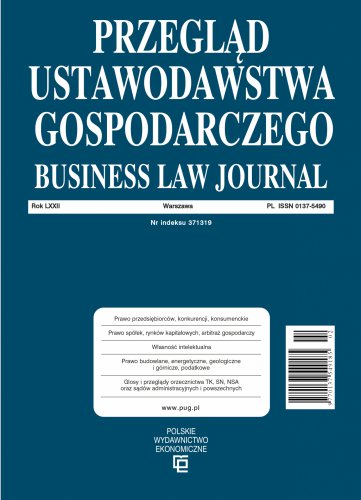The new projected status of the entrepreneur Trust and Check in the EU customs turnover
The EU legislator's proposal to create a new status of a Trust and Check entrepreneur in customs turnover is the result of the reform of the customs union and the introduction of facilitations in customs turnover. And basing it on the AEO institution and the status of authorized AEO entrepreneurs creates the foundations for moving the business and customs partnership to a higher level based on the principle of customs compliance in customs turnover for exporters and importers, thus creating a third group of entrepreneurs in customs turnover – Trust and Check entrepreneurs, in addition to the already existing: AEO economic operators and ordinary economic operators with different levels of cooperation with customs authorities, customs facilitations and the level of customs security assurance. The aim of the article is to present the assumptions and criteria for access to the Trust and Check institution and to compare it with the currently existing AEO institution as well as future planned changes within this institution. The implementation of this goal in conjunction with the analysis of the concept of customs turnover and the designed legal definitions of the exporter and importer will contribute to finding the answer to the main research question: Why is the EU legislator designing a new status of Trust and Check entrepreneur in the EU customs turnover, basing it on the existing AEO status?
References
Grant Thornton. (b.d.). A guide to Authorised Economic Operator (AEO). https://www.grantthornton.co.uk/globalassets/aeo-talkbook.pdf (pobrano: 23.01.2023).
European Commission. (b.d.). EU Customs Reform. https://taxation-customs.ec.europa.eu/customs-4/eu-customs-reform_en (pobrano: 23.07.2023).
European Commission. (2020). Guidance Document on Customs Valuation Implementing Act Arts 128 and 136 UCC IA, and Art. 347 UCC IA, Brussels, 28 April 2016, Taxud B4/ (2016) 808781 revision 2. https://ec.europa.eu/taxation_customs/sites/default/files/docs/body/guidan-ce_valuation_en.pdf (pobrano 15.05.2023).
Gwardzińska, E. (2014). Pozycja konkurencyjna przedsiębiorców AEO na rynku unijnym i Międzynarodowym. International Business and Global Economy, 33, 506–518. https://doi.org/10.4467/23539496IB.13.037.2422
Gwardzińska, E. (2020). Pojęcie importera w obsłudze celnej towarów w oparciu o nowe zasady ustalania wartości celnej towaru w Unii Europejskiej. Monitor Prawa Celnego i Podatkowego, (12), 427–431.
Gwardzińska, E. (2023). The AEO system as a diagnostic and verification tool for compliance with customs legislation. W: P. Karwat, K. Kimla-Walenda, & A. Werner. Tax Compliance and Risk Management Perspectives from Central and Eastern Europe. Routledge. https://doi.org/10.4324/9781003456032
Gwardzińska, E., & Gwardzińska-Chowaniec, Ż. (2022). Upoważniony przedsiębiorca w obrocie gospodarczym. Akademia Ekonomiczno-Humanistyczna.
Gwardzińska, E., & Tymińska, I. (2018). Eksterytorialne rozumienie pojęcia „eksporter” w unijnym prawie celnym. Monitor Prawa Celnego i Podatkowego, (12).
Kamela-Sowińska, A. (2015). Obrót gospodarczy jako dobro prawne chronione przez ustawę o rachunkowości. Prace Naukowe Uniwersytetu Ekonomicznego we Wrocławiu, (390).
PWN. (b.d.). Działalność biznesowa. W: Słownik języka polskiego PWN. https://sjp.pwn.pl/slowniki/biznes.html
Snażyk, Z., & Szafrański, A. (2010). Publiczne prawo gospodarcze (wyd. 2), C.H.Beck. 79–83.
WCO. (b.d.). Framework of Standards to Secure and Facilitate Global Trade. http://www.wcoomd.org/ (pobrano: 23.01.2023).
Wilk, L. (2011). Prawnokarna ochrona obrotu gospodarczego. W: S. Kalus i in. (red.), Ochrona prawna obrotu gospodarczego. LexisNexis.
Wolter, A., Ignatowicz, J., & Stefaniuk, K. (2001). Prawo cywilne. Zarys części ogólnej. LexisNexis.
Akty prawne/Legal acts
Rozporządzenie delegowane Komisji (UE) 2015/2446 z 28.07.2015 r. uzupełniające rozporządzenie Parlamentu Europejskiego i Rady (UE) nr 952/2013 w odniesieniu do szczegółowych zasad dotyczących niektórych przepisów unijnego kodeksu celnego, Dz. Urz. UE L 343 z 29.12.2015 r., https://eur-lex.europa.eu/legal-content/PL/TXT/PDF/?uri=CELEX:32015R2446
Rozporządzenie Parlamentu Europejskiego i Rady (UE) nr 952/2013 z 9.10.2013 r. ustanawiające unijny kodeks celny, Dz. Urz. UE L 269 z 10.10.2013, z późn. zm. https://eur-lex.europa.eu/legal-content/PL/TXT/?uri=CELEX%3A32013R0952
Rozporządzenie wykonawcze Rady (UE) nr 282/2011 z 15.03.2011 r. ustanawiające środki wykonawcze do dyrektywy 2006/112/WE w sprawie wspólnego systemu podatku od wartości, Dz. Urz. E L 77 z 23.03.2011 z późn. zm. https://eur-lex.europa.eu/legal-content/PL/TXT/PDF/?uri=CELEX:02011R0282-20220701
Wniosek rozporządzenia Parlamentu i Rady ustanawiającego unijny kodeks celny i Urząd Unii Europejskiej ds. Celnych oraz uchylający rozporządzenie (UE) nr 952/2013, Komisja Europejska, 17.05.2023 r., COM(2023) 258 final 2023/0156 (COD). https://eurlex.europa.eu/resource.html?uri=cellar:b2fb9bcf-f871-11ed-a05c-01aa75ed71a1.0011.02/DOC_1&format=PDF

